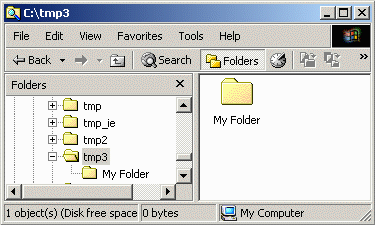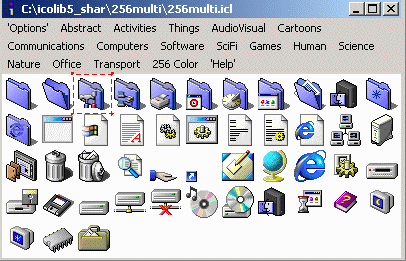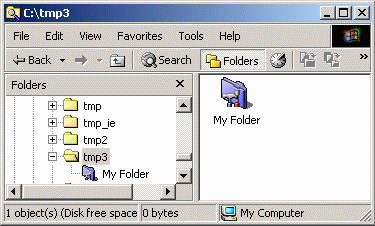|
|
|
|
|
|
|
 Application Notes 1a
Application Notes 1a
Section Contents
Table of Contents Changing Desktop Icons, Drives, Folders, Files, Shortcuts, System
How to change various icons on your desktop. Using More Than 16 Colors, 256 colors, 64K Colors, 16M Colors
Allow desktop to display icons with 256 or more colors Managing an Active Collection
How to manage icons you commonly use on your system. Deriving Your Own Icons
Create your own icons using Icon Library as your starting point. Icons as Bitmaps, Web Pages, ClipArt, Photoshop, GIF, JPG
Save icons as bitmap images and use them in web pages and other art.
Changing Desktop Icons
Drives |
Folders |
Files |
Shortcuts |
System
Folders
You can change the icon for individual folders by following these steps.
Choose a folder for which you want to change the icon, for example...

Create a file called Desktop.ini in the folder (My Folder)
for which the icon is to be changed. In this file add the following lines...
- [.ShellClassInfo]
- IconFile=c:\icolib5_shar\256multi\256multi.icl
- IconIndex=2
- InfoTip=New Icon in this folder
For this example I am using the 3rd icon, as specified by the
IconIndex parameter (count starts at 0), in this Icon Library category.

You may want to make the Desktop.ini into a hidden file so it
is not accidently deleted. Right click on the Desktop.ini file and
select the Properties option at the bottom of the popup menu.
Select the Hidden attribute and click OK.

The final step is to make the folder into a System Folder. You
can only do this from a DOS window. You can open a DOS window by selecting the
Run option from the Start button menu. Type command into the
input field and click the OK button and a DOS window should appear.
For this example, type attrib +s "c:\tmp3\My Folder" to convert
My Folder into a system folder. The icon for the folder should now have been changed wherever it appears.

There is a small side effect in changing your folder into system folder.
If you try to move the folder to another location, you will get this warning

Unless the folder is a real system folder, just click the Yes button. It is probably a good idea to have a single directory, for example,
c:\icons where you store any icon you use elsewhere in your system. I believe that Windows XP users can change folder icons simply by using
the Properties menu for the folder. You can now try changing the icons for some of your Files.

|
|
|
|

